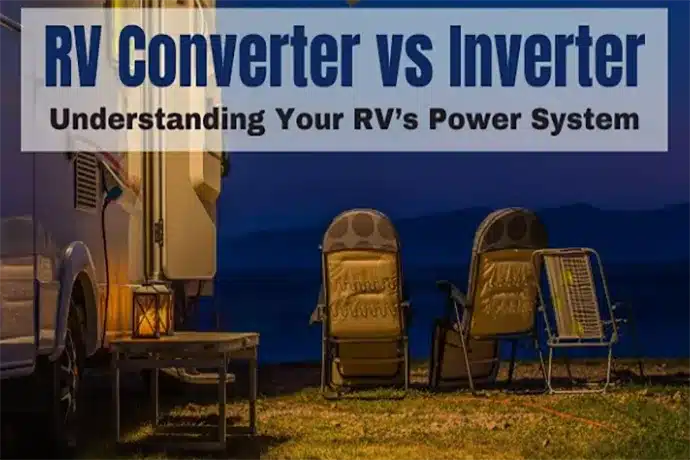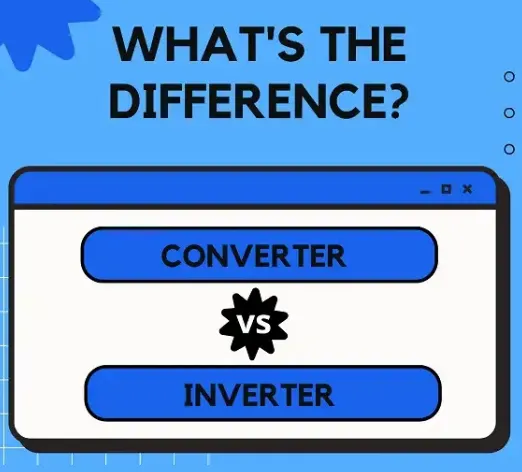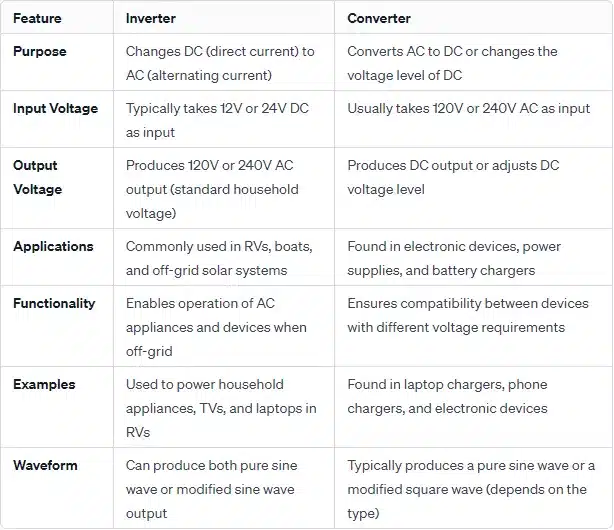Table of Contents
Do you own an RV and wonder whether an RV inverter vs converter can generate sufficient power for your devices?
Well, like most RV owners, you may face a dilemma between buying a converter vs inverter rv.
It’s only natural that many people are very confused when it comes to choosing components for their RV electrical system|Camper electrical system, especially if they are not familiar with all the terminology.
Maybe you’re planning a new trip, or building a DIY conversion campervan, when you’d really like to have an efficient energy system.
Therefore, this blog post will detail everything you should know about power inverters and converters.

RV Camper Electrical Basics | DC and AC Power
Direct Current: DC Power
- Definition: Direct Current: DC power is the type of current that flows continuously in one direction.
- Characteristics: DC power is often used in battery-powered equipment where the direction of the current remains constant.
- Symbol: DC power is usually represented by a smooth horizontal line.
This shows that DC current flows continuously in one direction, from the negative pole to the positive pole. This power type is very efficient for storage in batteries for RV campers, wilderness camping, and off-grid living.
Just for off-grid living, batteries are limited, so the goal is to use low-voltage appliances whenever possible.
Any device with a battery (such as a cell phone) uses DC power, while appliances designed to use AC power (such as a home refrigerator or TV) do not use DC batteries directly.
Alternating Current: AC Power
- Definition: Alternating current is a type of current that varies periodically in direction.
- Characteristics: It is usually used in household appliances and public power grids and varies in direction at a fixed frequency (Hertz).
- Symbol: Alternating current is usually represented by a sine wave.
Alternating current is a source of power generated by power plants and delivered to miles of power lines. It is the type of power source typically used in businesses and household appliances.
The flow of alternating current is less than oscillating, and its current constantly changes direction. This movement produces electricity, making long-distance transmission more efficient and suitable for delivering large amounts of energy to homes and businesses over national networks.
However, AC power cannot be stored, so power plants must manage their production around the clock (24/7) in response to demand from across the country.
What is a converter?
Electrical converter for rv is an electrical device whose main function is to change the form of the power source. It works by converting voltage, which can be increased or decreased as needed.
Unlike a van power inverter, which converts direct current (DC) to alternating current (AC), a converter typically changes the voltage level but maintains the same current.For example, in an RV or automobile where batteries provide DC power, a camper power converter is used to reduce the voltage to operate devices that require less power, such as telephones or small appliances.
Similarly, in home solar installations, the converter adjusts the voltage to avoid over-voltage to safely power various electronic devices, ensuring that they receive the right amount of power for optimal functionality.
RV electrical converters play a vital role in preventing damage to electrical equipment. This device plays a key role in various scenarios to ensure power stability and proper functioning of the equipment.
Types of converters
There are various types of RV AC to DC converters, depending on their purpose and working principle. The following are some of the common types of converters:
AC to DC converter (controlled rectifier)
Function: Converts alternating current (AC) from the grid to direct current (DC) for charging batteries or driving DC appliances.
Application: Critical in solar systems, enabling integration of solar and conventional grid power.
DC to DC Converter (DC Chopper)
Function: Regulates the voltage level of a solar panel to meet the needs of the battery or load.
Application: Important in solar installations to ensure efficient use of collected solar energy to optimize performance and battery life.
AC to AC Converter (AC Voltage Regulator)
Function: Regulates the AC voltage level to maintain a stable power level to the equipment or grid.
Application: In advanced solar energy systems, especially in systems with variable energy demand, it can be used to maintain a stable level of power to the equipment or grid.

What is an inverter?
An inverter is a device that converts voltage from direct current (DC) to alternating current (AC) at a specific frequency and voltage.
The received DC is the input and the AC that powers the device is the output. The output produced by an inverter can be a pure sine wave, a modified sine wave, or a square wave.
Most properties in the United States use inverters to store energy and use it as a backup power source to light homes, offices, and factories.
Take, for example, a house that requires about 250 volts of AC power. The only power available may be in the form of DC. With a RV solar inverter, you can still provide enough power to the house and everything will run perfectly.
DC and AC inverters are necessary for any electrical device or equipment that requires a DC power source to provide AC power.
Types of Inverters
There are various types of best rv inverter including:
String Inverter: The most common type and cost effective. It converts the DC output of multiple solar panels into AC power by connecting them in “strings”.
Microinverter: These Microinverters are connected to individual solar panels, converting DC to AC at each panel. This setup improves overall efficiency, especially under different shading conditions or roof orientations.
Hybrid Inverter: Especially suitable for solar systems with battery storage. Hybrid inverters are able to convert solar DC to AC and manage the charging of the batteries, allowing for energy storage and use during peak demand or power outages.
These different types of inverters meet the requirements of different systems and needs, providing a more flexible and customized solar solution.
Pros and Cons of RV Converter vs Inverter
Pros of Inverters
- EFFICIENCY: Inverters are very efficient and are an essential component of many electrical installations.
- Versatility: There are many types of inverters to choose from to suit different budgets and needs.
- Fast Response: Inverters respond quickly to cooling loads and heating equipment.
- EMI: Reduces the risk of electromagnetic interference with other equipment.
Disadvantages of inverters
- Power Requirements: Requires a stable power supply to fully utilize its functions.
- Not suitable for sensitive equipment: Not suitable for sensitive equipment with stringent power quality requirements.
- Less Effective with Motor Loads: This may not be as effective with motor loads as other devices in some applications.
Benefits of Converters
- Reliability: Converters are very reliable as they do not have any mechanical moving parts.
- Efficient: Converters are very efficient with minimal power loss.
- Fast Response: Fast dynamic response for situations that require quick adjustments.
- Portability: Most converters are very portable and compact.
Disadvantages of Converters
- Overload capability: Some converters may have relatively low overload capability.
- Cost: Some auto-regulators are very expensive and may increase the cost of the system.
Difference Between RV Inverter vs Converter
Although both inverters and converters transform voltage, they perform opposite operations.
Converter: Converts AC power to DC power and can also change the voltage level, for example from 120V to 12V.
Inverter: Converts DC to AC and also changes the voltage level, e.g. from 12V to 120V.
For example, in a campervan, an inverter can be used to run appliances through the campervan battery pack, while a converter is used to charge the camper battery pack. These two work together to ensure efficient operation of the electrical system and availability of the appliances.
I’ve summarized the differences between RV inverters and converters in a chart as shown here:

Why do RVs need power inverter or converter?
It depends on the situation.
If you need AC power to charge batteries or power appliances, a converter, inverter, or both are essential.
If you only use DC appliances and charge your batteries via solar or alternator, you can avoid not having a converter or inverter in your campervan.
Remember that AC appliances cannot be run on DC power. So how do you use your TV or coffee maker without the grid?
This is where you will need to change the DC power source from batteries to AC power.
It’s worth noting that a 12v DC battery can’t be charged directly from AC power either.
It is like a battery on a laptop, the battery needs DC power to charge.
Plug the cable into an AC outlet. Before the cable is connected to the laptop, electrical energy is converted from AC to DC in the power adapter.

























